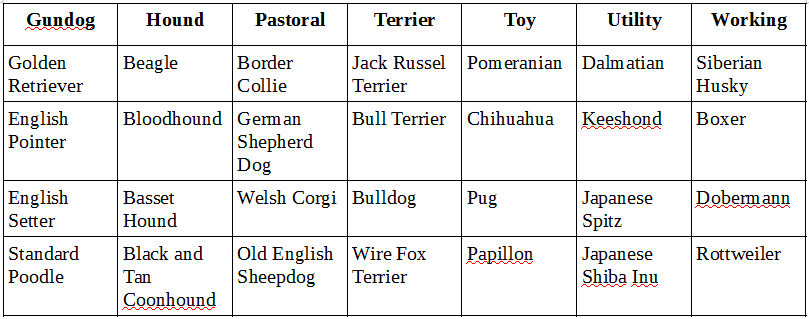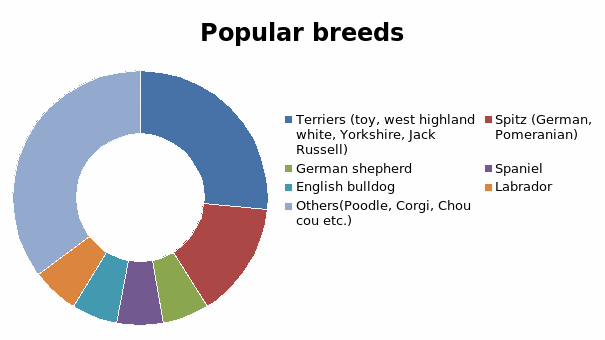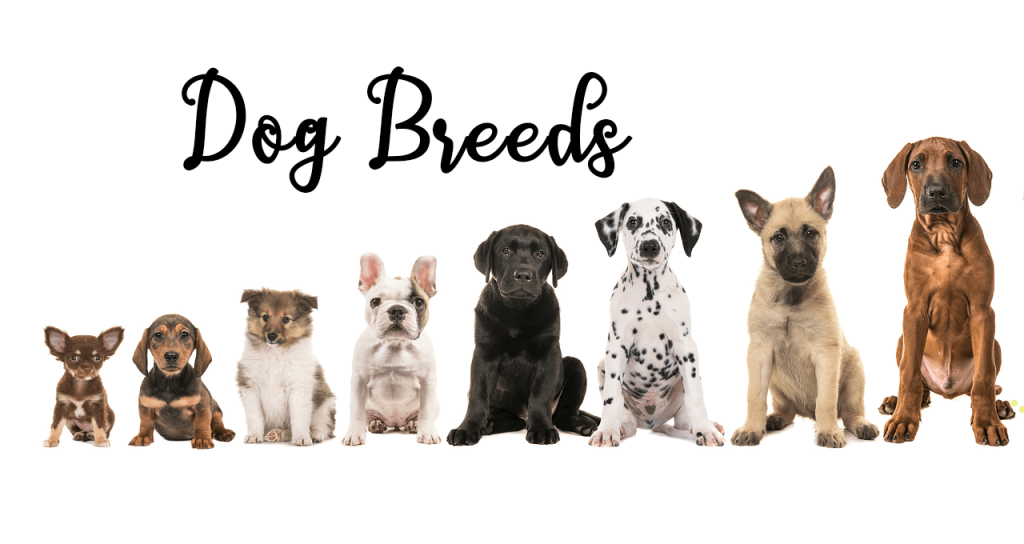Департамент образования мэрии города Новосибирска
Дворец творчества детей и учащейся молодежи «Юниор»
Городской конкурс исследовательских проектов
учащихся 9-11 классов
Секция: Английский язык (лингвистика)
The origin of the names of dog breeds in English language
Автор: Клепикова Ирина Олеговна,
МАОУ «Лицей №9»,
9 класс, Центральный район г. Новосибирска
Консультант проекта: Рогожникова Виктория
Александровна,
учитель английского языка
первой квалификационной категории
Контактный телефон руководителя:
8 913 380 32 95
Новосибирск
2021-2022
Портфолио проекта
Проект : Происхождение названий пород собак в английском языке
Участники проекта: Клепикова Ирина Олеговна
Консультант проекта: учитель английского языка первой квалификационной категории Рогожникова Виктория Александровна.
Класс: 9
Название, номер учебного учреждения, где выполнялся проект: МАОУ «Лицей №9», Центрального района, города Новосибирска.
Предметная область: английский язык, лингвистика, культурология.
Время работы над проектом: август 2021 г. - ноябрь 2021 г. (долгосрочный).
Проблема проекта: откуда произошли названия пород собак в английском языке
Цель проекта: провести исследование происхождения названий пород собак и морфемный анализ существительных, обозначающих породы собак .
Задачи: - организовать поиск информации по истории происхождения названий пород в Великобритании;
- провести морфемных анализ существительных, использующихся для названия пород собак;
- провести анкетирование учащихся лицея №9 с целью выяснить, имеют ли они собаку и какой породы, чтобы выяснить наиболее популярные породы для содержания в квартире.
Тип проекта (по виду деятельности): лингвистический , исследовательский. Используемые технологии: мультимедиа.
Форма продукта проекта: доклад (мультимедийная презентация для недели иностранных языков) с таблицами иконографикой.
Содержание: поиск информации по истории появления собственно пород собак и их названий в Великобритании, ознакомление с типологией британских пород собак , проведение морфемного анализа существительных, используемых для обозначения пород собак в английском языке, результаты анкетирования учеников лицея.
Исследование: - изучение истории одомашнивания собаки, типов пород собак, проведение опроса учащихся по предложенным вопросам, поиск ответа на вопрос о наиболее популярных британских породах собак в России.
Область применения результата проекта: - учебная (уроки английского языка, языковые погружения, классные часы); - внеклассная работа (кружковая работа по углубленному изучению английского языка, родительские собрания и др.); - социальная (сотрудничество, помощь учителям, работавшим в нашей школе, профориентация - презентация материалов на неделе иностранных языков для 5 классов.
Результативность: создана мультимедийная презентация по теме, создан список наиболее удобных для содержании в квартире пород собак , проведена системная работа над темой «Словообразование в английском языке» на примере образования названий пород собак.
Plan:
Page
Introduction 5
The origin of the names of dog breeds in English 6
The history of dog breeds names 7
Typologies of dogs breeds 8
The morphemic analysis of breeds nouns 8
Popular dog breeds 9
Conclusion 12
References 13
Applications 14
I. Introduction
The theme of my reporting paper is «The origin of the names of dog breeds in English ». Most of my friends and classmates have dogs as pets. Now I'm really interested in the topic where did the names of breeds in English come from and whether these breeds are popular in Great Britain and Russia. Besides, I’m not having a dog at the moment and I'm going to get one. To do this, I decided to study the popularity rating of different hound breeds and make an ideal portrait of a dog for keeping in an apartment.
I decided to make a research to know how the names of British dog breeds appeared and make a survey between my classmates, relatives and friends about popular dogs breeds in Russia .
The following aim was set in the work on the project:
There are following tasks:
to study different typologies of dog breeds;
to conduct the morphemic analysis of the British breed’s names;
to a survey and find out the most popular British dog breeds in Russia among classmates and acquaintances;
based on the conducted research, to make a list of the most popular and convenient dog breeds to keep in a flat.
During our work at the topic we have used following methods of study:
method of historical research;
method of typology;
method of morphemic analysis and comparison;
method of survey.
II. The origin of the names of dog breeds in English
Dog breed is a particular strain of dog that was purposefully bred by humans to perform specific tasks, such as herding, hunting, and guarding. First of all I wanted to know how the names of British dog breeds appeared.
The word dog is the bête noire of English etymology. Without obvious cognates anywhere (the languages that have dog are said to have borrowed it from English), it had a shadowy life in Old English but managed to hound from its respectable position the ancient name of man’s best friend, the name it has retained in the rest of German.1
A few such names are self-explanatory: for example, spaniel and Bolognese (Spain, Bologna). Some easily give away their Romance roots: terrier is such (terra “earth”); others, like beagle and mastiff, are considerably less transparent. Poodle, from German, seems to designate a creature fond of splashing in puddles. Collie, we are told, is related to coal because the earliest breed was black.
According to Anatoly Lieberman, a well-known researcher of the etymology of various words in various European languages, the words for “dog” and its breeds sometimes go back to epithets like “fierce,” “tame,” “swift,” “loud,” and even “musical” (the latter two describe the animal’s bark) or the predominant color (collie is not the only example). 2
In this theory, he gives many examples, as a result and comes to the conclusion that hound may be similar to Latin canis “dog,” but the vowels match badly and final -d has never been explained. The idea of the affinity between hound and the Gothic verb meaning “catch” (hinþan; þ = th) was given up long ago, even though this approach is rather attractive and originated with no less a figure than Jacob Grimm. Also, hunt is not a relative.
2.1. The history of dog breeds names
Dogs are probably the descendants of the gray wolf. The first demonstrable signs of relationships between man and wolves date back to 10.000 to 15.000 years ago.
The dog was domesticated earlier than any other animal, and during this time people managed to breed more than 200 breeds of dogs to serve them for various purposes.
Scientists agree that the dog was domesticated in the Old World in the Upper Paleolithic era, but there is still no consensus in the scientific community about the exact place, time period and reasons for the domestication of the dog. The main role of the dog of this period was an assistant on the hunt.3
Individual dog breeds usually got their names because of some characteristic feature. For example, bulldog was used to work with bulls, harrier is named after it’s prey (hare), Pomeranian was bred in Pomerania (a province of Prussia) and a bloodhound has an instinct to track blood by smell.
2.2. Typologies of dogs
There are currently about 400 recognized dog breeds in the world. Dog breed is a particular strain of dog that was purposefully bred by humans to perform specific tasks, such as herding, hunting, and guarding.
The Kennel Club4 - the official kennel club of the United Kingdom and the oldest recognized kennel club in the world, that main activities include dog shows, dog agility and working trials, defines 7 groups of dogs:
Hound group
Working group
Terrier group
Gundog group
Pastoral group
Utility group
Toy group
The Kennel Club was founded by Sewallis Shirley in 1873, who had organized the first dog show in 1859 in Birmingham. Since that time, the club has been organizing and holding dog breed exhibitions, approving new requirements for new dog breeds.
The main kinds of breeds are presented in the table below:5

2.3 The morphemic analysis of breeds nouns
Studying the various names of dog breeds, I paid attention to the form of the words of the breed designations themselves. This interested me all the more, since many dog breeds in Russian were borrowed from English.
The formation of nouns in English occurs in one of the following ways: 6
Simple – nouns without suffixes / prefixes, words are presented only in the base form . In our table tea nouns are Beagle, Chihuahua, Poodle, Pug etc.
Derivatives – nouns formed by adding a suffix / prefix. The examples are: Pointer, Dalmatian and so on.
Compound nouns are made up of two or more simple words, e.g: Bloodhound, Bulldog, Dashhound etc.
To designate a breed, is also often used the name of the area where this breed was bred, or parts of the word denoting two crossed dog breeds. In English, there are also names of breeds borrowed from other languages, for example from German or Japanese, such as Rottweiler or Akita.
2.4. Popular dog breeds
Currently, there are about 400 dog breeds in the world. Among them there are breeds that are spread all over the globe and have a huge number of individuals, such as the German Shepherd.
The most popular dog breeds of 2021all over the world according to the survey results of Pets- Global. com are:7
Labrador Retriever
German shepherd
Golden Retriever
French bulldog
Bulldog
Beagle
Poodle
Rottweiler
Yorkshire terrier
German shorthair pointer
Speaking about Great Britain, the TOP 5 most popular breeds according to pets4homes.co.uk are:8
French bulldog
Chihuahua
Pug
Cockapoo
Cocker spaniel
In Russia the most popular breeds according to News. Rambler.ru are:9
Pomeranian Spitz
Yorkshire terrier
Chihuahua
German Shepherd
Toy Terrier
Of course, I was interested in popularity of different breeds between my classmates, relatives and friends and conducted a survey, the questions of which sounded like this:
1. Do you have a dog, and if so, what’s the breed?
2. Why have you chosen this breed?
In total, 60 people took part in the survey. 35 (58%) of respondents) have got a dog as a pet at home.
The results of the survey you can see in the diagram and the bar chart below:10
The most popular breed among the respondents is a “Terrier” of different kinds. Then there are Pomeranians, German, spaniels, etc. The results of my surveys coincided with the rating of breeds in Russia in the main positions.
Reasons for keeping

22 people have chosen a breed based on its characteristics such as size, training capabilities, character, etc. 6 respondents have got a dog as present and 7 persons have other reasons for keeping a pet.
According to a survey and research of the most popular breeds in the world, Britain and Russia, I have identified the most popular requirements for choosing a breed in the conditions of keeping in a flat.
First of all, the dog should be small, friendly, shedding little. The next requirement is undemanding in care and easy to train. In our study, it turned out to Terriers of all kinds - Jack Russell Terrier, Russell Terrier, etc. Most respondents of pedigree dogs have preferred this breed.
III. Conclusion
In conclusion I would like to say:
Dog breed is a particular strain of dog that was purposefully bred by humans to perform specific tasks, such as herding, hunting, and guarding.
The names of breeds in English are divided into 3 groups according to morphemic characteristics: simple, derivatives and compound nouns.
After conducting a survey, we found out that the most popular dog breeds among the respondents are Terriers of different kinds, Pomeranians, German, spaniels, etc. The results of my surveys coincided with the rating of breeds in Russia in the main positions.
For me personally, it became clear that the most convenient breed to live in the apartment is a small shorthair dog, easy to train, which sheds a little and gets along with children. I will probably choose the Yorkshire Terrier - one of the most popular British dog breeds.
References
Information sources:
Ваулина Ю.Е., Дули Д., Подоляко О.Е., Эванс В. Английский язык. 9 класс.- М.: Express Publishing: Просвещение, 2019. – 136 с.
Дули Д., Эванс В. Grammarway 2.- М.: Центрком, 2012. – 176 с.
Мюллер. В.К. Новый англо-русский словарь. – М.: Русский язык, 2004. – 880 с.
Algeo John. The origins and development of the English language. Wadswoth, Gengage Learning, 2010. – 348 c.
Daniel Brayshow. Focus 3 Workbook. – Harlow: Pearson, 2020. – 175 c.
Jenny Dooly, Virginia Evans. Grammarway 3.- Newbury: Graham Business Park, 2015. – 272 с.
Sue Kay, Vaughan Jones, Daniel Brayshaw. Focus 3 Student’s book. – Harlow: Pearson, 2020. – 160 c.
The Pocket Oxford Russian Dictionary//comp. by J. Coulson. – М.: ИНФРА– М, 2002. – 624 с.
Internet sources:
https://animalfreedom.org
https://blog.oup.com/2016/05/dog-etymology-word-origin-part-1-tyke/
https://www.bostonterriersociety.com/dog-name-origins/
https://info.wikireading.ru/
https://lovelylanguage.com/grammar/grammar-rules/english-noun
https://www.mentalfloss.com/article/25492/how-13-dog-breeds-got-their-names
https://news.rambler.ru
https://pets-global.com/ https://pets-global.com/
https://www.pets4homes.co.uk/
https://en.wikipedia.org/wiki/Dog_breed
https://en.wikipedia.org/wiki/The_Kennel_Club
https://en.wikipedia.org/wiki/Dog
Application 1
Typology of dog breeds according to Kennel Club


Application 2
Results of survey
60 respondents – 35(58%) keep a dog.
1) Do you have a dog, and if so, what’s the breed?
| Dog breed | Number of respondents |
| Terriers (toy, west highland white, Yorkshire, Jack Russell) | 9 |
| Spitz (German, Pomeranian) | 5 |
| German shepherd | 2 |
| Spaniel | 2 |
| English bulldog | 2 |
| Labrador | 2 |
| English setter | 1 |
| Poodle | 1 |
| Zwergpinscher | 1 |
| St. Bernard | 1 |
| Corgi | 1 |
| Dachshund | 1 |
| Maltese dog | 1 |
| Pekingese | 1 |
| Bichon frise | 1 |
| Chow chow | 1 |
| Mongrel | 1 |
| East Siberian laika | 1 |
2) Why have you chosen the breed?
| Reason for keeping | Number of respondents |
| Based on a certain breed characteristic (size, character traits, etc.) | 22 |
| Picked up or was a gift | 6 |
| Other reasons | 7 |
1�https://blog.oup.com/2016/05/dog-etymology-word-origin-part-1-tyke/
2� https://blog.oup.com/2016/05/dog-etymology-word-origin-part-1-tyke/
3� https://animalfreedom.org
4� https://en.wikipedia.org/wiki/The_Kennel_Club
5�See: Application 1
6� https://lovelylanguage.com/grammar/grammar-rules/english-noun/
7�https://pets-global.com/ https://pets-global.com/
8�https://www.pets4homes.co.uk/
9�https://news.rambler.ru
10�See: Application 2
13




























